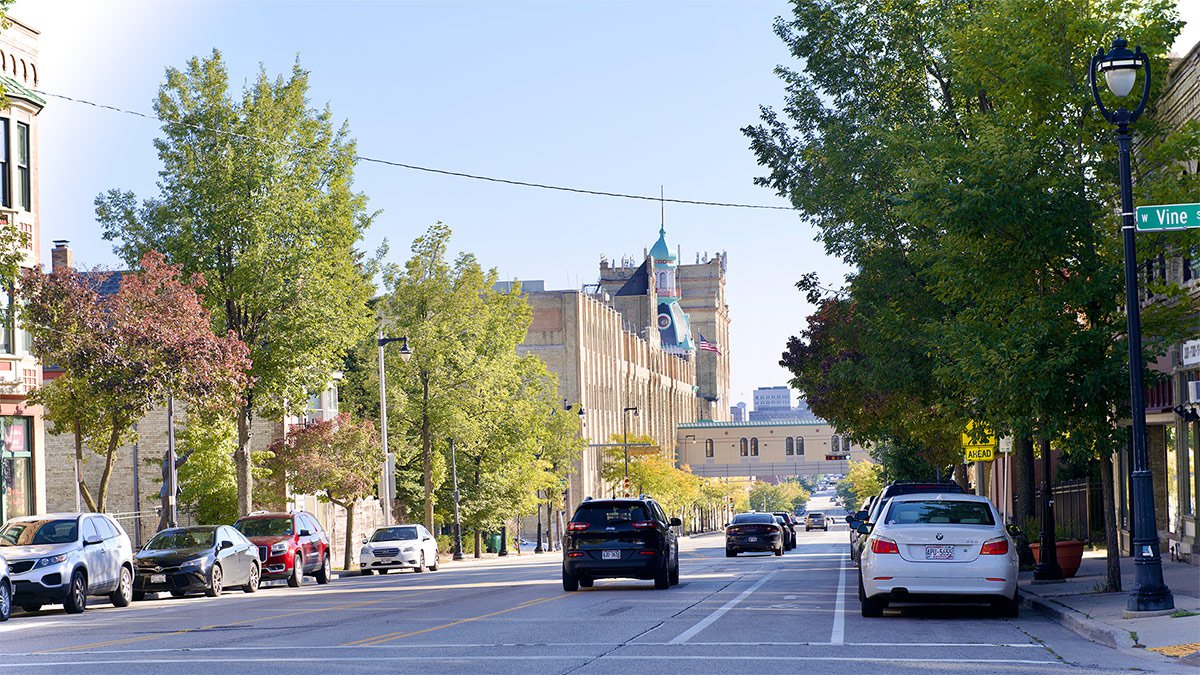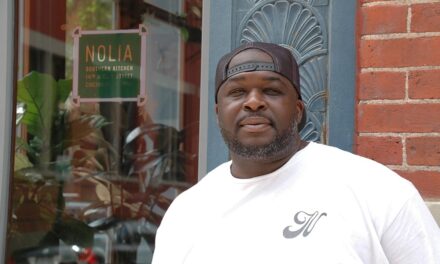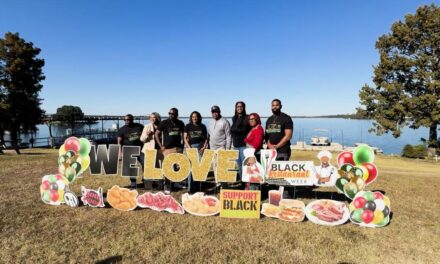
If you live in the Milwaukee area, you have probably heard the term BID (Business Improvement District). A BID is a defined area within a city where local businesses and property owners work together to improve their environment. In Milwaukee, there are a total of 30 BIDs.
Since 1992, BID 8, the Historic King Drive Business Improvement District, has overseen more than $700 million in new developments. BID 8’s mission is to improve the district through a culture that embraces a trendy and authentic retail experience while attracting businesses who commit to hard work.
As executive director of BID 8, Ray Hill has a big job. Since 2021, she has been leading the charge to improve the ML King Drive corridor, which has been challenging for close to a generation. For several years, I’ve been walking the corridor, chatting with residents and business owners, and observing infrastructure improvements but hoping for more. Ray Hill is making progress. “BID 8 is a mechanism to uplift commercial property owners and provide resources from other partners, with the goal of revitalizing King Drive,” she once said.
Recently, Hill and I shared a couple couches at Honeybee Sage on ML King Drive in the heart of Bronzeville, a gathering place for residents to socialize and business owners to share ideas. Ray Hill is soft spoken, earnest, and with a calm conversational style that airs credibility through a voice pleasant on the ears.
Tell me about your background, where you grew up, your parents, your schools.
I grew up on the North Side near Villard and Teutonia. My parents were both blue collar workers. I graduated from Riverside University High School. Good experience for me, wonderful school. Then, I went to the Milwaukee Area Technical College (MATC) and then to Waukesha Tech. My goal was to be in the criminal justice system as a detective. But I changed my mind and transferred to Concordia University. Meanwhile, I got married and had my first son when I was 20. By the time I finished college, I had two children.
In your career, you have worked in a number of different venues. I believe you have held jobs in the private, nonprofit and public sectors.
I have been working since I was 14. My first job was at the Northwest Side Community Development Corporation. I was taking surveys of residents for the redevelopment of Capital Court. I’ve also worked at a lot of retail and hospitality jobs. At 19, I worked for the Amcore Bank in the real estate department, and I eventually became assistant and acting branch manager. In 2007, I got recruited by Dave Byczek, a real estate developer, to be an executive assistant as his National Management Company. Then, the mortgage crisis happened. Dave began acquiring multi-family units, and I was learning about property management. I worked at National Management for nine years, and I left the I was the operations manager. Essentially, I was running the company.
It seems like you had learned a lot about real estate at that point in your career.
I did, but I decided to move on. Dave Byczek sponsored me to attend ACRE, Associates for Commercial Real Estate, at Marquette University. In 2015 and 2016, I went through the ACRE program. I then became the associate director of Milwaukee’s Business Improvement District 8, BID 8. I left there after two years, and worked at the nonprofit CommonBond Communities, a multifamily real estate developer for affordable subsidized housing in Milwaukee. For part of my time there, I did fundraising for wraparound services that help residents establish a holistic way of life—financial literacy, home workshops, senior fitness and other wellbeing activities.
How did you become Executive Director of the Historic Business Improvement District No. 8?
The BID 8 job opened up in 2021, and I went for it. I’ve been the Executive Director for almost two and a half years.
What area of the city does BID 8 cover?
It’s the ML King Drive corridor. To the south, we cover McKinley, then west to Sixth Street, and east to the Milwaukee River. To the north, the district runs all along King Drive up to Capital Drive but includes North Avenue west to the freeway. Essentially, we cover all of Bronzeville.
And what are your job responsibilities as Executive Director?
Generally, my job is to steward the team to attract and retain businesses in the ML King Drive corridor. I play an active role to help our Bronzeville businesses. I am the liaison to the services that the city can provide. We make sure our businesses have access to those services. We also have a strong hand in marketing the businesses and the Bronzeville area. We recruit and promote, and once a business is up and going, we do a lot to help it stay here. We connect people who may want to start a business to the property owners, but the main focus is on people who are already here.
Let’s say I want to open a business in the BID 8 corridor. I contact you for help. Can you suggest different commercial spaces that might be open for renting or purchase?
Absolutely. You would fill out a questionnaire to describe your needs. We will then pair you with property owners who have vacancies. This might involve real estate brokers. We can also connect you with the city if you need licensing or other resources. We consider ourselves as a one-stop shop to help you start and retain your business.
Right now, we are sitting in the Honeybee Sage Wellness & Apothecary Cafe. It seems to be thriving. How have you helped this business?
We are a neighborhood partner of Brew City Match, a nonprofit that assists small businesses with grant funding. Honeybee Sage received direct capital from Brew City Match. In general, if we hear of a grant, we might ask a business to apply. The grant might cover staff, rent, original and equipment costs, also marketing and building infrastructure.
In my anecdotal observation, the area south of the general area along North Avenue and the ML King Drive corridor seems on the way to thriving. There is the huge old Gimbels Store now converted into the new ThriveOn King building with retail, restaurant, large offices and soon, 90 new apartments. Next door, there is the beautiful new Howard Fuller Collegiate High School. There is Gee’s Clippers Barbershop, the Black Holocaust Museum, Victoria Beauty Supply Shop, Pete’s Fruit Market, the Bronzeville Estates Housing, and the Bronzeville Creative Arts & Tech Hub, soon to be breaking ground.
We are excited about that general area’s growing success. Keep in mind that this is a lot of years of work. With the help of Alderwoman Milele Coggs, there has been the development of the Bronzeville Zoning Overlay, which specifies specific uses and designs for North Avenue. That includes commerce and art culture.
There is still a big need for development along King Drive from North Avenue north to Center Street and on up to Locust. That area is not doing too well. Vacant buildings, empty lots. As I see it, investment would be useful.
Our goal along that part of the corridor is to create more commercial new construction and more green space. Right now, there is a lot of concrete. But going further north from Locust, the corridor shows success, for instance, the new ML King Library with 90 apartment units and the beautiful Bader Philanthropies building.
I have an idea. How about if we take a walk.
I would love to show you around …
Walking Bronzeville
We stepped outside into a summer day, the sun shining out of an azure sky, the traffic light. We walked for a few blocks along ML King Drive, feeling a downtown vibe. The buildings are mostly new or rehabbed and seemed to be thriving with tenants. For instance, I noticed the office of dentist, Bruce Hamilton. Hill said, “Dr. Hamilton’s dental business has been here for a long time, very successful.”
As we continued on, we passed the Mi Casa Su Cafe and a bordering alley with chairs and tables for meals, coffee and conversation. “One of our great local cafes,” she said, “and it has just expanded. They now have the outdoor seating. The cafe hosts poetry nights, music and other social events.”
Hill pointed out some colorful signs attached to streetlight poles. “These signs are part of our improvement plans,” she explained. One sign featured silkscreened art lettered, Halyard Park, She said, “Halyard Park started development in 1976 with loans from Columbia Savings & Loan, the only Black-owned bank in Wisconsin, financed by Ardie and Wilbur Halyard.” Later on in our walk, we came across another marker sign that explained the history of Halyard Park.
We passed a long, large two-floor building of tan brick. Hill said, “This building houses the Benedict Center on the first floor. It specializes in women services. On the second floor are the offices of the Black-owned JCP Construction. JCP assisted in the construction of Fiserv Forum where the Milwaukee Bucks play their games.”
As we moved further north along the King Drive sidewalk, I noticed that almost every commercial building was new or rehabbed, and filled with stores, offices and apartments. We passed the YWCA, the African-American Chamber of Commerce, then a fitness cycling bar, and nearby, the North Shore Bank branch.
I said, “I think the plan or at least the hope of this part of the King Drive corridor is that it will one day attract people from all over as a destination, kind of like the Third Ward is now doing. But I find that people still seem reluctant to walk this street.”
She said, “I think this street is now walkable and also pays homage to the history here. We want to celebrate the people and the culture of this area. We hope more people will visit.”
We came to Food for Health, the former Fein Brothers Restaurant and Supply original warehouse, and then Crown Hardware, a landmark business in the corridor.
Hill led me to another streetlight marker in the next block. “This marker recalls Bronzeville history from the 1930s through the 1950s,” she explained. “My grandfather is featured on the sign as that silkscreened figure on the artwork. His name was Lawrence Hill, and in 1946 he owned the Chicken Shack on 619 West Walnut not far from where we are standing. In 1951, my grandfather was part of the Northside Business Advancement Association. 70 years later in 2021, I became executive director of BID 8. It’s like my family legacy is right here on ML King Drive.”
For more information on the King Corridor, visit kingdriveis.com/what-we-do.




